How to Apply the 5 Pillars of Marketing to SEO (& Get Results)

Hand off the toughest tasks in SEO, PPC, and content without compromising quality
Explore ServicesIf you work in marketing, you know how much can change in the industry.
It’s obvious:
Marketing best practices evolve with the market.
The internet has led to fast and significant change for the marketing world and what strategies are effective. If you’re in the industry, you need to keep up with the times.
How people shop and browse online is very different than how they used to, and you need to update your strategies to be successful.
However, there are some things that remain the same.
Want to know how to apply the pillars of marketing to your SEO? We wrote this guide to help.
What Are the Pillars of Marketing? (& How Many Are There Exactly?)
Marketing pillars represent all the areas of focus that marketers can control.
When you are making a marketing plan for a new campaign, you can ignore any of them at your peril. Following each of the 5 pillars of marketing should form the best marketing practices on everything you do.
For a long time, the industry focused on 4 pillars of marketing.
However, the internet has changed the landscape for marketing. Now there is a significant service-based industry online that marketers cannot ignore.
That has led to the addition of a fifth pillar, bringing the list to:
- Product — before anything else you need a product (or service) to sell.
- Price — you need to set your prices that people will accept and help your business.
- Place — you need to sell your product where people will actually buy it.
- Promotion — you need to promote your product in a way that will resonate with customers.
- People — you need to have the right people executing your marketing plans.
You might also hear of as many as “7 P’s of marketing”, with Process and Physical Evidence included in the list. They will be addressed towards the end of this guide.
Monthly SEO packages 📅
Give us your site or clients and we’ll get to work on improve organic traffic. We’ll audit the site, then create a content strategy and build links that will move the needle… every month.
How to Apply the Marketing Pillars to SEO
Now it’s time to look deeper into how to apply the marketing pillars to online marketing and the world of SEO.
While you can apply the same general principles to SEO, there are some specifics to be aware of.
Here’s how you can apply each of the five pillars to your SEO strategies:
1. Product
The product (or service) that you want to sell to your customers needs to be at the center of any marketing plan.
This is also true for SEO. You need to know what it is you want to sell through your website before you start to optimize it for search engines.
If you are an eCommerce business, you will sell products through your website. If you are a service-based business, you will sell your service to clients who book appointments.
You can also be an online service that offers a tool that customers can download or subscribe to use.
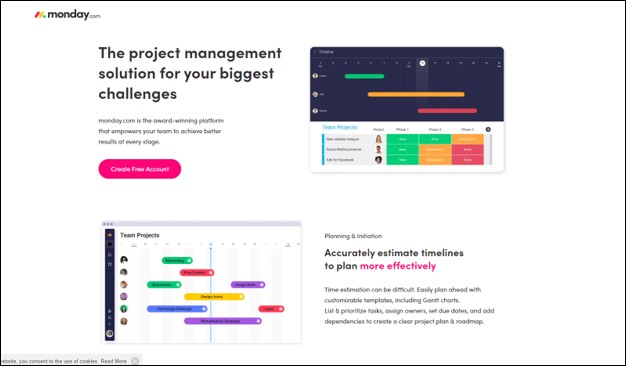
Screenshot from: https://monday.com/ft/mb/ni/projectmanagement/bundle/
To succeed in creating an SEO marketing plan around your product or service, you need to know why your customers would want it.
What problems do they have that it could solve? What are their pain points? How does your product help them better than others?
To come up with an SEO strategy that answers these questions, you can use the following tools or resources:
- Competitor research — use SEO tools to assess what your competitors do to market their products.
- Keyword research — find out what words people search for about your products and services.
- Topic research — look into what questions people ask online that relate to what you sell.
These will give you valuable insights into the needs of your potential customers. SEO tools like SEMRush and Ahrefs have features to cover all three of those strategies.
2. Price
The next step is to figure out the value and the price of your product.
The value is what your customers want to pay for the type of product, while the price is how much you actually sell it for. You should also keep in mind what price works best for your business.
Selling a product at the lowest price compared to competitors is a good way to get more sales. But selling it for a higher price as a ‘premium’ or higher quality product can lead to better profits.
What price you sell at can also tie in to your branding, so keep in mind how you want to present your business.
There are other ways where pricing models can tie in to your marketing. For example, you might advertise financing or payment plans to make the prices seem lower. Or you may offer flexible subscription payments that are more friendly to customers.
Take the SEO industry itself:
Ahrefs did a study on the pricing for SEO services that various companies offered. The study found that most SEO companies offered a mix of hourly, monthly, and per-project rates:
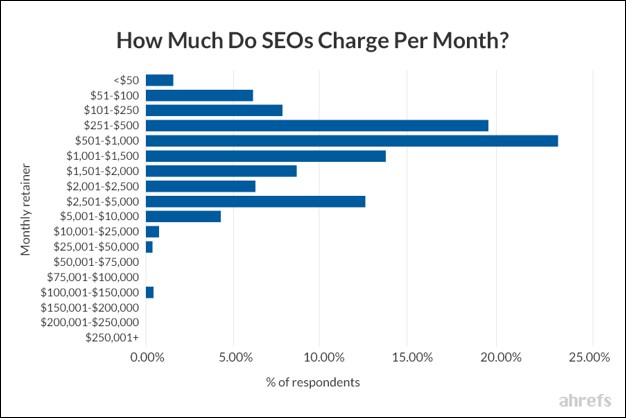
Image from study referenced above: https://ahrefs.com/blog/seo-pricing/
3. Place
For digital marketing, the “place” is where you put your business online so customers can find you.
The main focus would be your website, especially for SEO. But you should not neglect things like Google My Business, social media, online directories like Yelp, and so on.
If you are a restaurant or hotel, you should have a profile on TripAdvisor, Yelp, and so on. If you are in the home renovation industry, your business needs to be on one of the major contractor directories like:
- Homestars.com
- Houzz.com
- Angieslist.com

Screenshot from: https://homestars.com/on/toronto/bathroom-renovation
An eCommerce business would not get the same return on investment in directories like that.
But they should put their products on Amazon, Etsy, or Facebook Marketplace where they can sell their products directly to customers.

Do the research to know how customers in your industry shop online.
Do they look for your website? Do they search through local search engines like Google Maps? Do they shop on a third-party eCommerce platform like Amazon?
When you know where to find your potential customers, you know the Places where you need to advertise.
4. Promotion
The next step is to figure out how you can get your marketing campaigns in front of customers online.
For SEO, that means search engines such as Google, Bing, Yahoo, and so on.
Optimizing your website for search engines puts your website in front of customers as they search for what you’re selling.
Whether that is physical products like ‘iphone cases’:
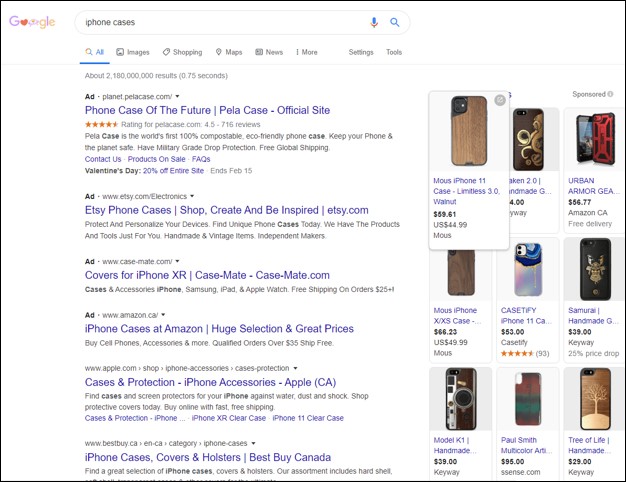
Or for local services:
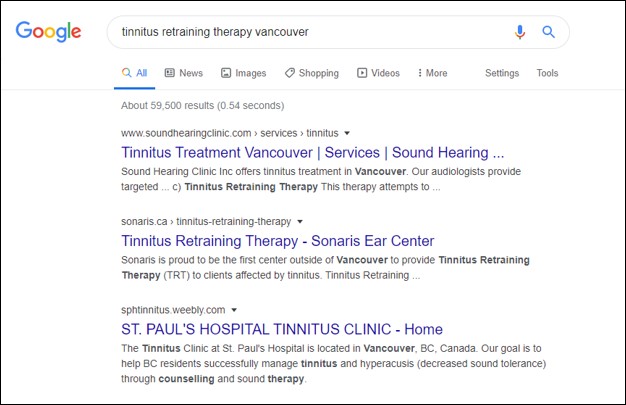
Don’t forget:
You can also advertise your product on search engines and directories.
This gets your website at the top of organic and local searches so prospective customers see you first. The best part of search engine marketing is that you are targeting interested shoppers.
For instance, something like Yelp is perfect for restaurants:
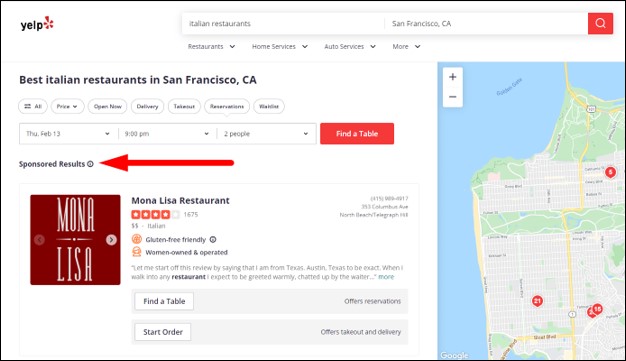
When people are actively searching for the type of product or service you’re selling, you want to get your marketing in front of their eyes. You can find case studies on SEO campaigns to see just how effective it can be.
5. People
‘People’ became one of the pillars of marketing because of the internet and the rise of the service industry. When people shop for a service online, they want to know more about the person that will be doing the work.
Think about it. When you are looking online for a roofer, plumber, lawyer, or any other service business, don’t you want to know about them?
You want to know about their years of experience, and what reviews they have from past customers. You want to see pictures of them, and to know that they are real people.

Customers don’t trust unnamed or invisible business entities for services. That’s why SEO for any service-based business should know what people they need to market to their prospective customers, and how.
That’s because in the service industry, people are the product. The people and what they can do are what the customers are interested in, especially for services online.
Sidenote: What are the 7 P’s of marketing?
The 7 P’s of marketing is a variation of the main five pillars discussed above.
Created by E. Jerome McCarthy in the 1960’s, it offers a more comprehensive approach to marketing. It does so by touching on two new areas that may not apply to every business, especially online. Those two new pillars are Process and Physical Evidence.
Here is a quick list of the 7 pillars and what they touch on:
- Product — quality, branding, features, availability, etc.
- Promotion — marketing campaigns, communications, PR, etc.
- Price — price points, discounts, payment plans, financing, subscriptions, etc
- Place — channels, stores, websites, online platforms, etc
- People — customer service, recruitment, branding and culture, etc.
- Process — research and development, design, slogan, business practices, etc
- Physical evidence — online experience, product packaging, etc
To expand on Process, it refers to the whole system that’s central to your business. Do you research and develop your own product, or do you source it from someone else? How do you train employees in customer service? What process do you use for generating leads, or for converting them into a sale?
Physical evidence refers to how you prove to customers that they should trust you. Does your product look like it’s high quality, or shoddy? Do your staff present clean and professional? Do you have a physical location they can visit to speak with you and see your product in person?
You can see how they do not directly touch on your marketing, but how they can influence each other.
Summary
The pillars of marketing is an effective concept for planning your marketing strategy from top to bottom.
It makes you ask a lot of very important questions that you will need to figure out, and it can help you find areas of improvement to work on fixing.
When it comes to SEO, that means applying the same general concepts to the online world.
The mechanics for marketing your product or service on the internet works differently than older methods. But by investing in your online marketing, you can get the fantastic results you want.
Hand off the toughest tasks in SEO, PPC, and content without compromising quality
Explore ServicesWritten by Aaron Haynes on March 26, 2020
CEO and partner at Loganix, I believe in taking what you do best and sharing it with the world in the most transparent and powerful way possible. If I am not running the business, I am neck deep in client SEO.





